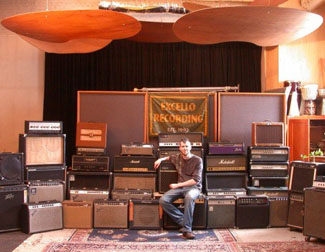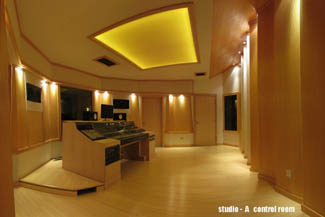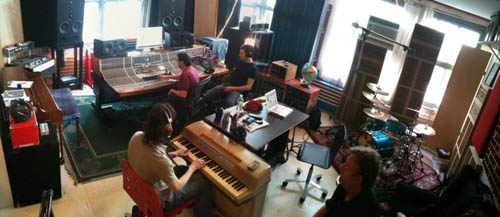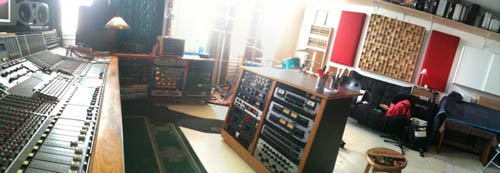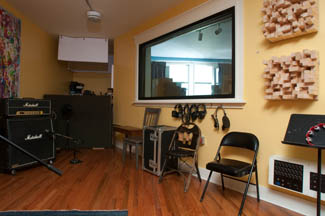NYC Studio Tour: North Brooklyn, Part 3
NORTH BROOKLYN: Brooklyn correspondent Justin Colletti continues to visit a wide array Brooklyn recording studios. This installment features one of North Brooklyn’s most impressive new build-outs, as well as a studio that may be among the area’s oldest, and rootsiest.
—
EXCELLO RECORDING
East Williamsburg
http://www.excellorecording.com
Contact for Rates
Studio owner Hugh Pool is a man who began his career busking in New York City’s subways, and ended up as the unlikely owner of one of Williamsburg’s longest-standing studios.
In a neighborhood now known for indie rock, contemporary art, and trend-jumping youth culture, this Dobro-slinger still has his heart deep in the gritty, visceral blues he grew up on.
As a guitarist, Pool has shared the stage with Patti Smith, Johnny Winter, Gov’t Mule and John Mayall, his tastes tending toward the rough and determined sound of early blues pioneers likes of Howlin’ Wolf, Little Walter, and Blind Lemon Jefferson.
“You listen to some of those old records and sometimes you don’t even hear chord changes,” he says, “Just these slightly dissonant guitar lines beating against each other. At times it doesn’t even sound like a band – more like one giant machine.”
Although he describes blues-based rock-and-roll as “what comes most effortlessly” to him, Pool’s interests and expertise don’t end there. Since opening its doors in 1992, his studio, Excello, has played host to projects from Richard Hell, Steve Albini, They Might Be Giants, Deborah Harry, Ellis Ashbrook, and Rufus Wainwright.
Bands looking to record live will appreciate Excello’s surprisingly ample recording space — a wide, open 40 x 25 tracking room with 17-ft ceilings.
“If I was looking for a studio, I’d track here,” says Pool, who’s accumulated a motherload of 35 amplifiers, to complement his six tape machines, Pro Tools HD rig and vintage Calrec console. Maintaining all this gear, Pool says, has helped keep in-house tech John Charette busy for years.
Continuously operating in one location for nearly two decades has also meant that Pool has seen plenty of new studios lay roots nearby as this neighborhood continues to gentrify and evolve. Eventually, this would even include a new room popping up right across the street. Almost 10 years ago, Oliver Straus opened the doors at Mission Sound (profiled in December 2010) a literal stone’s throw away.
“I remember when he moved in,” says Pool. “We didn’t know each other at first, but completely independently of us, our wives started becoming friends because we both had kids the same age who were starting to play together on the block.”
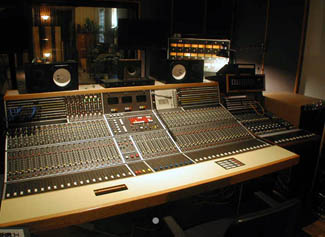
Excello’s control room, featuring the 58-input Calrec Series B OB console, 2-channel Neve 1063 sidecar and 10-channel rack of API 312s
As a pleasant surprise, the two grew to feel more camaraderie than competition.
“His room is great for what he does,” Pool continues. “Sure, there’s some overlap, but our interests and our rooms are completely different.”
“Given that everyone’s functioning on a competent level, it just comes down to where the best fit is. It’s important that the band goes for the right vibe, and once that trust is established, then you get going. In the 10 years we’ve been across the street from each other I don’t think we’ve ever had to slug it out over a client,” he laughs.
“The only time we’ve even had a conversation [about booking] is when someone who’s real wacky – clearly out to lunch – takes a look at both of our places. Then we might call each other up just to dish about it a little.”
According to Pool, clients end up seeking him out for his guitar prowess as much as his engineering chops. When he does find himself booked on double-duty, he regularly hands over the Calrec’s reigns to staff engineer Nathan Rosborough, a budding and capable recordist in his own right.
—
3 EGG STUDIOS
Williamsburg
http://www.3eggstudios.com
Contact for Rates
Brian Penny, house engineer at Williamsburg’s newly-built 3 Egg Studios, tells us that he and his partners have “the flattest mix room in New York” and that they have the measurements to prove it.
If looks say anything, this studio’s startlingly pristine control room gives the impression of having been painstakingly carved from a single block of wood.
The studio’s suite of floated live rooms are just as striking as the control room, and reminiscent of some of the most coveted tracking spaces that lie across the East River.
Penny calls 3 Egg’s live rooms “supremely isolated,” and says their easy sight-lines make them perfect for musicians interested in “live-off-the-floor tracking with discrete, accurate sounds.”
For those with more organic tastes, a system of soundproofed sliding glass doors can be opened to dial-in bleed to taste, giving the sense of an even larger room.
Though rates are not published on the web, our conversations with the studio staff assured us that this impressive space is also priced affordably for indie artists who are serious about their sounds. Penny also calls 3 Egg “super-freelancer friendly” – the studio comes equipped with multiple DAWs, including Samplitude, Ableton, Cubase, Logic, and Pro Tools HD.
—
COWBOY TECHNICAL SERVICES
South Williamsburg
http://www.cowboytechnical.com
Contact for Rates
Eric “Roscoe” Ambel has been remarkably active in the music industry his entire adult life.
Follow his 30-year career down the road of straight-ahead rock n’ roll and you’ll find him playing guitar for Joan Jett, The Del Lords, Steve Earle and Run DMC, writing and performing his own songs, producing critically-acclaimed albums in the roots-rock tradition, and running both an LES music venue called Lakeside Lounge, and in 1999, opening a Williamsburg recording studio known as Cowboy Technical Services.
In what appears to be becoming a growing trend in the neighborhood, Ambel, along with partner Tim Hatfield (Keith Richards, Death Cab For Cutie) and engineer Greg Duffin (Regina Spektor, Wilco) have recently upgraded their studio by moving to a newer, better, space several blocks away from their original location.
In 2009, they re-opened shop with Brad Albetta (Teddy Thompson, Martha Wainwright) to unveil the new Cowboy Technical.
One thing that’s stayed the same in the move is the team’s overall design philosophy: The new studio is built in a style Ambel calls “One Room Plus,” essentially an open-plan, console based (BBC Calrec), analog/digital studio with two additional isolation rooms.
Ambel feels this setup allows for a “unique workshop-style environment” that’s been ideal for musicians who are eager to dive deep into the studio’s collection of vintage instruments while working out arrangements and perfecting performances with producers and engineers who’ve lived and breathed music for their whole lives.
—
THE KENNEL
East Williamsburg / Bushwick
http://www.thekennelstudio.com
Contact for Rates
Although they built the Kennel’s fully isolated live rooms “as an homage to the great old studios,” Jim Santo and his partners took great care to be sure they would avoid creating an “engineer-centric” studio that might feel like a “hermetic cage.”
This taste shows throughout The Kennel, which includes an overhead skylight and large outdoor windows that allow plenty of natural light into the studio.
“Our goal is to be as invisible as possible,” says Santo. “We encourage the artist to be as comfortable in the studio as they are in their own home.”
Ultimately, he considers their space “an artist-focused” studio: “When you come here, there’s no need to spend four hours getting a kick drum sound. We’re here to capture the energy and keep it coming.”
Santo says the owners and engineers at the Kennel don’t feel competition with neighboring studios, instead tailoring their space to reel back in some of the musicians who have rejected conventional studios for a variety of reasons:
“Today, what we’re really competing against is recording at home. Here, you have that same level of comfort, but you also have the controlled environment, top-notch equipment, and people who are experienced and care about what’s going on in the room.”
The Kennel is equipped with an AMR 2400 console, 24-track tape machines from Otari and Tascam, and a 32 I/O Pro Tools HD system.
Through its monthly “Rabid In The Kennel” Internet radio show, The Kennel has played host to the likes of Lou Barlow, The Posies, Mitch Easter, and Sloan. In addition to Santo and co-owner James Pertusi, producer/engineers Wharton Tiers (Sonic Youth, Helmet) and Billy “Prince Polo” Szeflinski (Yeti Beats, VP Records) also call this studio home.
Justin Colletti is a Brooklyn-based producer/engineer who works with uncommon artists, and a journalist who writes about music and how we make it. Visit him at http://www.justincolletti.com.
Please note: When you buy products through links on this page, we may earn an affiliate commission.







